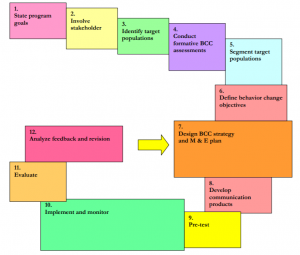
Table of Contents
What is Behavior Change Communication (BCC)?
- Behavior Change Communication (BCC) is a communication strategy which encourages individual/community to change their behavior.
- It is a strategy that triggers people/society/communities to adopt healthy, beneficial and positive behavioral practices.
- BCC is an effective communication approach which helps to promote changes in knowledge, attitudes, norms, beliefs and behaviors
- BCC is an interactive process with communities (as incorporated with a general program) to create custom-fitted messages and methodologies utilizing an assortment of correspondence channels to create positive practices; advance and support individual, network and cultural conduct change; and keep up suitable practices.
- BCC is a powerful and fundamental human interaction – communication – which positively influences dimensions of health and well-being.
- BCC is a direct approach towards changing behavior. It is different to traditional IEC materials as IEC materials are not considered for creating awareness and giving information as compared to BCC.
- BCC is described by its straight approach towards changing behavior.
Criteria For Developing BCC Messages:
BCC messages must be:
- Research centered
- Client centered
- Benefit Leaning
- Service Interrelated
- Professionally developed, and interrelated to behavior change
Importance of BCC:
- Increase in knowledge and attitude of the people
- BCC helps to trigger and stimulate people for adopting positive behavioral approaches
- BCC promotes appropriate and essential attitude change
- As BCC strategies and messages are tailored for specific target groups, these strategies are efficient and effective.
- BCC approaches are more sustainable and acceptable
- BCC helps to increase learning and skills
- It improve aptitudes and feeling of self-adequacy
Apart from these, importance of BCC at different levels are:
- At individual-level
- BCC helps in learning, mindfulness, convictions, and sentiments about wellbeing practices. It plays a significant role in deciding wellbeing conduct.
- At community-level
- BCC approach stimulates community to take ownership towards the approach. Additionally, it will also help the community to replicate the positive practices in bigger level.
- At national level
- BCC will play a significant role in lobbying & advocacy of certain practices. These approaches will support and encourage government and other stakeholders to bring a positive whim among all the citizens for adopting positive behavioral practices.
Guiding Principles of BCC:
The guiding principles of BCC are:
- BCC should be integrated with the goal and objective of the program
- Formative BCC assessments must be carried out while developing BCC messages
- Target population must participate during BCC development
- Key and direct stakeholders need to be involved from the design stage of BCC
- Pre-testing must be done for effective BCC materials
- BCC programs must involve planning for monitoring and evaluation.
- BCC strategies must be positive and action oriented.
Strategies While Developing BCC Messages:

Developing BCC messages include:
1. Analysis
- Comprehend the idea of the issues and hindrances to change.
- Tune in to a potential group of spectators, survey existing project approaches, assets, qualities, and shortcomings and investigate correspondence assets.
2. Strategic Design
- Settle on destinations, recognize crowd portions, position the idea for the group of spectators
- Explain the conduct change model to be utilized, select channels of correspondence, plan for relational discourse, draw up an activity plan, and structure for assessment.
3. Development, Pretesting, Revision, and Production
- Create message ideas, pretest with a group of spectator’s individuals and guards.
- Amend and produce messages/materials and pretest new and existing materials.
4. The executives, implementation, and monitoring
- Implement the BCC and carry out continuous monitoring to see the positive and negative effects.
- Conduct critical analysis of the approach.
- Make sure that the messages coherent with the objective of the BCC.
5. Making arrangements for continuity
- Acclimate to changing conditions and plan for progression and independence.
BCC Strategies in Health
- User identification
- Community Mobilization: Mass media for making mindfulness for national projects like adolescent wellbeing, MCH wellbeing administrations, and so forth.
- Platform: Home visits, gatherings
- Target population: Identify the key target population of the message
- Advancement of healthy behavior messages: MCH, Nutrition, Contraception, Adolescents, Health, Hygiene, Sanitation, Epidemics, and so on.
Limitations of BCC:
a) Material-focused as opposed to conducting focused:
- In most of the cases, BCC approaches are considered as ‘material-focused’ rather than ‘conduct focused.
- This implies the greater part of the consideration; time and assets go into the generation of materials, (for example, handouts).
- In any case, while alluring materials may grab somebody’s eye, they do not without anyone else persuade individuals to change conduct.
b) Limited capacity within local line agencies:
- Local agencies and organizations might not have enough skills and ability to develop triggering BCC messages.
- There may be limited abled human resource to facilitate the process of effective BCC message generation
- BCC messages if not prepared without having proper idea about the context of the target population might be useless and go in vain.
References and For More Information:
http://www.hivpolicy.org/Library/HPP000533.pdf
https://simavi.org/long-read/behavioural-change-communication/
http://hands.org.pk/live/?p=6203
http://www.hivpolicy.org/Library/HPP000533.pdf
https://healthcommcapacity.org/about/why-social-and-behavior-change-communication/
https://www.psi.org/program/behavior-change-communication/